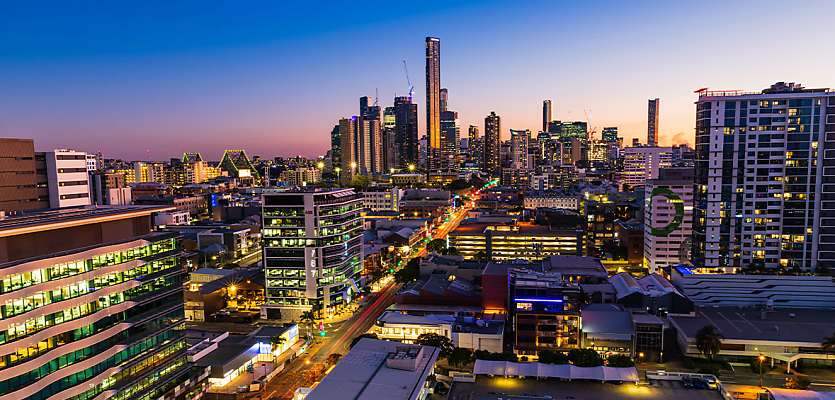Reports from CBRE and the Property Council of Australia (PCA) show Brisbane’s industrial and office space faces growing pressure, with supply constraints expected to continue due to rising demand and limited land.
A new CBRE report reveals that Brisbane will require approximately 1.2 million square metres of new industrial floor space over the next five years to keep pace with population growth.
However, the Brisbane Industrial and Logistics Land Supply report highlighted only 5 per cent (663 hectares) of the city’s total zoned industrial land remains undeveloped and serviced, exacerbating supply shortages.
CBRE research analyst, Charlotte Fordyce, said demand from transport and logistics, manufacturing and retail occupiers, along with a projected population ride of 260,000 by 2030, is exacerbating land shortages.
“The lack of available zoned land is particularly evident in the North, South and Australia TradeCoast precincts – areas that are becoming ever more sought after as last mile hubs,” she said.
CBRE reported that The Western Corridor and M1 Corridor have the largest shares of this land, at approximately 27 per cent each, while the Trade Coast North and Trade Coast South precincts have the lowest shares at 11 per cent.
“This is continuing to drive significant appreciation in land values, with the average value of large lots having doubled over the past three years,” Fordyce added.
CBRE’s Queensland industrial and logistics director, Matthew Frazer-Ryan, highlighted that Brisbane’s TradeCoast precinct has the least amount of undeveloped serviced land, with ownership concentrated among a limited number of institutions and private owners.
“Due to the limited land supply in the TradeCoast, we expect to see a new trend emerge, as owners seek to maximise the value of existing sites by replacing outdated and obsolete buildings with modern, state-of-the-art facilities that cater for evolving occupier demand and built form requirements,” Frazer-Ryan said.
The recent CBRE report noted that the industrial vacancy rate in Brisbane remains below 3 per cent, despite three consecutive years of above-average new industrial floorspace supply.
However, the report forecast moderate new supply over the next four years, averaging 294,99 square metres per annum – significantly below the 10-year average of 386,000 square metres.
According to CBRE, the decline in development is expected to drive further rent increases.
While industrial rents in Brisbane are already at record levels, the city continues to attract national occupiers who have been priced out of Sydney, according to the report.
CBRE also noted that In 2014, average prime rents in Sydney were 7 per cent higher than in Brisbane, but by Q4 2024, this gap had widened to 39 per cent.
On the commercial office front, Brisbane’s office vacancy rate remains below the national average at 10.2 per cent, with supply constraints expected to persist, according to the PCA.
Queensland executive director of the Property Council, Jess Caire, said Brisbane faces a shortage of new office space in the medium to long term, highlighting the need for urgent action to address supply issues.
“Vacancy rates in the south-east Queensland office market have been below the national average for several years, and it is difficult to see that changing given strong tenant demand and the lack of new supply due to the cost and complexity of delivering a new office building,” Caire said.
Caire also highlighted that while new projects, such as 205 North Quay and 360 Queen Street, will provide some relief this year, there are no major developments scheduled beyond 2028.
She stressed that new projects need to be in planning now to accommodate demand, particularly for the 2032 Olympic and Paralympic Games.
Brisbane saw a slight increase in office vacancy of 0.7 per cent compared to last year, but Claire stated that a lack of new developments highlighted the need for investment.
“As we look at Brisbane’s growth and the scale of what will be required to meet that demand, now is the time for a targeted investment attraction package that includes reviewing our planning settings and an overhaul of our prohibitive tax settings to kickstart private development,” Caire said.
Knight Frank partner, Jennelle Wilson, said that Brisbane’s office market remains strong despite the recent CBD office vacancy increase.
“Landlords have benefitted greatly from rental reversions with gross effective prime market rents up by 14 per cent in the past year, and 25 per cent over the past two years,” she said.
Wilson stated that premium and A-grade vacancies remain tight at 7.3 per cent and 8.3 per cent, respectively, while fringe office vacancies have fallen below 10 per cent for the first time in nine years due to sustained demand in key precincts.

Never miss a beat with
Stay across what’s happening in the Australian commercial property market by signing up to receive industry-specific news and policy alerts, agency updates, and insights from reb.
Subscribe to reb Commercial:









You are not authorised to post comments.
Comments will undergo moderation before they get published.